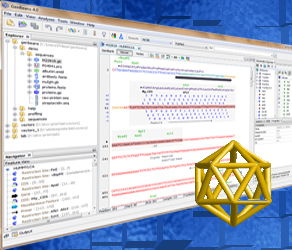ADVERTISEMENT
Protein Function Analysis
PredictProtein is a service for sequence analysis, structure and function prediction. When you submit any protein sequence PredictProtein retrieves similar sequences in the database and predicts aspects of protein structure and function
Harvester collects and displays bioinformatic protein information and predictions for human proteins from various databases for realtime access.
The aim of the ProFunc server is to help identify the likely biochemical function of a protein from its three-dimensional structure.
The iProClass database provides value-added information reports for UniProtKB and unique NCBI Entrez protein sequences in UniParc, with links to over 90 biological databases, including databases for protein families, functions and pathways, interactions, structures and structural classifications, genes and genomes, ontologies, literature, and taxonomy.
ANTHEPROT (ANalyse THE PROTeins) is the result of about 10 years of biocomputing activity of a group of the Institute of Biology and Chemistry of Proteins. The main idea was to integrate into a single package most of the methods designed for protein sequence analysis (1,2,3,4). This simple idea was originally supported early in 1988!
Web client for visualizing protein sequence feature information using DAS. Provide a highly integrated visualization of protein features; works by accession numbers.
The PANTHER (Protein ANalysis THrough Evolutionary Relationships) Classification System is a unique resource that classifies genes by their functions, using published scientific experimental evidence and evolutionary relationships to predict function even in the absence of direct experimental evidence.
SMART (Simple Modular Architecture Research Tool) allows the identification and annotation of genetically mobile domains and the analysis of domain architectures.
WebFEATURE allows a user to scan a molecular structure for a particular functional site (e.g. ATP binding site, calcium binding site, etc.).
The Prolinks database is a collection of inference methods used to predict functional linkages between proteins. These methods include the Phylogenetic profile method which uses the presence and absence of proteins across multiple genomes to detect functional linkages; the Gene Cluster method, which uses genome proximity to predict functional linkage; Rosetta Stone, which uses a gene fusion event in a second organism to infer functional relatedness; and the Gene Neighbor method, which uses both gene proximity and phylogenetic distribution to infer linkage.
Given either a protein structure in PDB format (<300 residues) or a protein sequence, the MFS server module will return a prediction of meta-functional signature: a score for each residue in the structure or sequence indicating its relative functional importance. In addition, for the submitted structure, a new structure file with the temperature factor field replaced by meta-functional signature scores will be created to enable visual inspection of functionally important regions using molecular graphics software.
This web site is a new tool to identify putative Protein Phosphatase 1 (PP1) binding proteins.
Prediction Of Unknown Sub-types (PROUST) II. Given a protein sequence alignment, and a classification of some or all of the sequences in the same alignment into functional or other sub-types, PROUST-II predicts positions in the alignment and particular amino acids in them that confer the specific types.
The Web Bench
The Web Bench
is the essential companion to the biologist, bringing informational resources and a collection of tools & calculators to facilitate work at the bench and analysis of biological data.
Check out the full online bench here
Check out the full online bench here
Sequence Analysis with GenBeans
 Try GenBeans: Best free software for DNA sequence editing!
Try GenBeans: Best free software for DNA sequence editing!
FEEDBACK
Your comments & your suggestionsare appreciated. Please, notify us for resources and tools that you would like to see on this bench!





